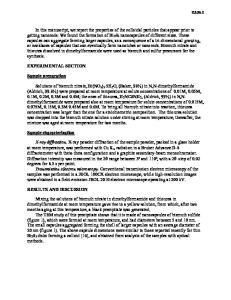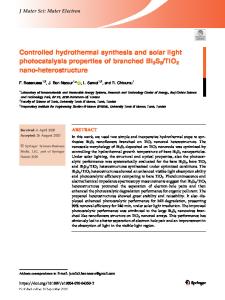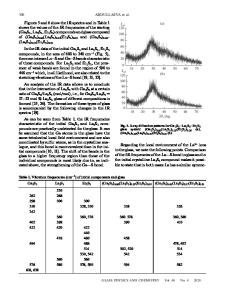Surfactant and thioacetamide-assisted reflux synthesis of Bi 2 S 3 nanowires
- PDF / 1,136,920 Bytes
- 16 Pages / 584.957 x 782.986 pts Page_size
- 2 Downloads / 331 Views
Yuxiang Yanga) and Junya Yang School of Chemistry and Molecular Engineering, East China University of Science & Technology, 200237, China
Hongming Yuan State Key Laboratory of Inorganic Synthesis and Preparative Chemistry, College of Chemistry, Jilin University, Changchun 130012, China
Jie An and Jing Wei School of Chemistry and Molecular Engineering, East China University of Science & Technology, 200237, China
Xiangnong Liu Analysis Test Center, Yangzhou University, Yangzhou 225009, China (Received 15 April 2014; accepted 9 July 2014)
Pure single-crystalline bismuth (III) sulfide (Bi2S3) nanowires with lengths of the long and short axes being 1.58–1.75 lm and 40 nm were prepared by a simple surfactant-assisted reflux method in the presence of thioacetamide, which served as both the sulfur source and a “soft template” in the formation of bismuth sulfide nanostructures. The effects of different surfactant, surfactant molecular weight, solvent medium, and sulfur source on the morphology, structure, and phase composition of the as-prepared Bi2S3 products were discussed. The formation of long Bi2S3 nanowires was probably via the mechanism of pyrolysis of bismuth (III) sulfide complexes dimer and continuous growth of crystalline nuclei along rod-shaped micelles originated from “soft-template” of polyethylene glycol (PEG-800). Besides, ultraviolet–visible spectroscopic (UV-Vis), and photoluminescent (PL) Bi2S3 band features indicated that the nanowires have excellent optical properties, in the optical field of potential applications.
I. INTRODUCTION
One-dimensional (e.g., nanorods, nanowires, etc.) nanostructured materials represent a class of quasi-1D materials in which carrier motion is restricted in two directions so that they usually exhibit significant photochemical, photophysical, and electron transport properties, which is different from that of bulk or nanoparticle materials. When the size of semiconductor nanocrystalline materials becomes smaller and smaller, the surface effect will be even more pronounced, the size and the morphology of nanocrystalline materials will make big effects on the physical property, called quantum size effect. Bismuth trisulfide (Bi2S3) is a ⅤA-ⅥB compound semiconductor material that crystallizes in the Pbnm orthorhombic space group, having complex band or layered lattice structure. Besides, Bi2S3 nanocrystallines also have prominent quantum size effect, therefore their photophysical and chemical properties have become one of the most active research areas rapidly, among which the a)
Address all correspondence to this author. e-mail: [email protected] DOI: 10.1557/jmr.2014.193 2272
J. Mater. Res., Vol. 29, No. 19, Oct 14, 2014
http://journals.cambridge.org
Downloaded: 15 Mar 2015
ultrafast optical nonlinear response and photoluminescence properties and other characteristics have attracted even more attention. By reason that Bi2S3 is a highly anisotropic semiconductor material, having layered structure, the growth direction of layered structures is found to form parallelly to the c
Data Loading...











